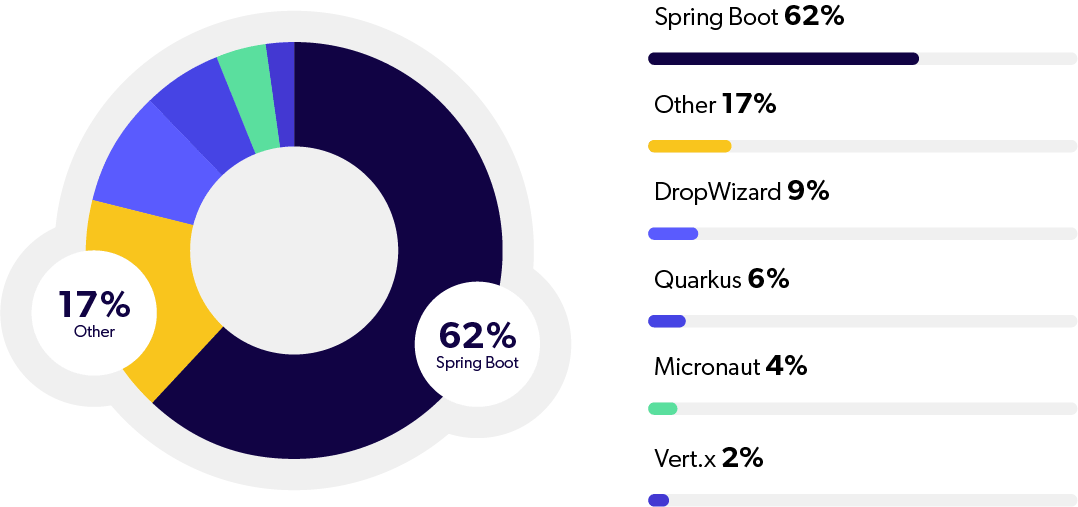Blog
October 26, 2021
According to our 2021 Java Developer Productivity Report, 62% of surveyed developers are using Spring Boot as their main framework technology. While this is the clear majority, it’s a drop from 2020’s 83% of respondents. This slight dip in popularity may be attributed to the rise in Spring Boot alternatives such as Micronaut, Quarkus, node.js, and more.
In this blog, we’ll compare Spring Boot to other framework options. If you are a Java developer looking to switch from Spring Boot to another framework, this blog can help you understand the pros and cons of the most popular Spring Boot alternatives.
Spring Boot Overview
You may know from our Spring Boot overview that Spring Boot is an open source, microservice-based Java web framework. The Spring Boot framework creates a fully production-ready environment that is completely configurable using its prebuilt code within its codebase. The microservice architecture provides developers with a fully enclosed application, including embedded application servers.
Spring Boot is just an extension of the already existing and expansive Spring frameworks, but it has some specific features that make the application easier for working within the developer ecosystem. That extension includes pre-configurable web starter kits that help facilitate the responsibilities of an application server that are required for other Spring projects.
Spring vs. Spring Boot
You’ve likely seen Spring mentioned before and may have mistakenly assumed it was the same tool as Spring Boot. Spring is a framework that provides developers with many modules to support developing Java applications. Spring Boot is basically an extension of Spring which fastens the time needed to start with development.
Spring Boot has many “starter” dependencies, which simplify the application configuration. Spring Boot also has an embedded server, so you can start your application right away without the complexity of traditional application deployment.
One of the great examples of simple configuration is Thymeleaf in Spring Boot, where the only thing you need to add is the spring-boot-starter-thymeleaf dependency and that’s it. With Spring, you would have to add dependencies, configure template resolver, template engine, and map view names using view resolver.
Dependency example:
<dependency>
<groupId>org.springframework.boot</groupId>
<artifactId>spring-boot-starter-thymeleaf</artifactId>
</dependency>Spring Cloud vs. Spring Boot
Spring Boot is a good technology and provides all the necessary things to develop microservices, but when it comes to distributed systems, some configurations may become duplicated. This is solved with Spring Cloud, which can be added to the Spring Boot application. Some of Spring Cloud’s other features include:
- Distributed/versioned configuration
- Service registration and discovery
- Routing
- Service-to-service calls
- Load balancing
- Circuit breakers
- Global locks
- Leadership election and cluster state
- Distributed messaging
Looking For Spring Boot or Spring Cloud Support?
Perforce OpenLogic provides SLA-backed technical support for Spring Boot, Spring Cloud, and other Spring Framework components, with expert assistance available 24-7-365.
Market Share
Almost half (49%) of developers in the 2021 Java Developer Productivity Report said they are using microservices as their main architecture. Because of this, Java tools and technologies that support the microservices architecture are largely popular. For frameworks, there’s no shortage of competitors gaining traction in the space.

Spring Boot leads the pack by a large margin, but a margin that is slowly closing. Let’s take a look at some of the other framework options developers are choosing and see how they compare to Spring Boot.
Back to topSpring Boot Alternatives
While Spring Boot is the clear favorite, it could be worthwhile to explore other frameworks. These alternatives are not all in Java, and some may be better for certain types of development (i.e. creating reactive applications) than others.
- Quarkus vs. Spring Boot
- Micronaut vs. Spring Boot
- Node.js vs. Spring Boot
- Django vs. Spring Boot
- Vert.x vs. Spring Boot
Quarkus vs. Spring Boot
Quarkus is a Kubernetes Native Java stack tailored for OpenJDK HotSpot and GraalVM. Designed with a container-first approach, Quarkus has a small memory footprint. It starts up fast, which has a positive effect on overall costs and resources.
| Quarkus Benefits | Spring Boot Benefits |
| Fast boot time | Embedded server |
| Low memory footprint | |
| Container-first approach |
Quarkus uses standards such as Eclipse MicroProfile or Eclipse Vert.x framework. The dependency injection is based on CDI.
Back to topMicronaut vs. Spring Boot
Micronaut is quite a young framework compared to Spring Boot. The goal of Micronaut is to simplify the microservice development lifecycle. Because it’s a “cloud-native” approach, many features are directly integrated into the framework while Spring Boot needs dependencies on third-party cloud services or libraries.
| Micronaut Benefits | Spring Boot Benefits |
| Cloud-native | Embedded server |
| Simplified microservice lifecycle | More ways to handle properties |
| Integrated service discovery | |
| Kubernetes supported by default |
Node.js vs. Spring Boot
Server-side-oriented web applications are no longer tied to only the Java world; you can write a world-leading application in JavaScript as well. Node.js is a server-side run-time environment that is built on the V8 JavaScript engine, so it can compile and execute JavaScript code.
| Node.js Benefits | Spring Boot Benefits |
| JavaScript runtime environment | Java Framework |
| Lightweight | Extensive features and better integration capability |
| Highly-scalable | Multi-threaded |
Node.js is widely used in big tech companies around the globe. For example, Netflix, the biggest streaming service, uses node.js.
Back to topDjango vs. Spring Boot
Python is one of the most popular programming languages, and when it comes to choosing the best framework for web development, Django is the perfect choice. It is a high-level Python web framework that is packed with dozens of extras to handle common web development tasks.
| Django Benefits | Spring Boot Benefits |
| Python framework | Java Framework |
| Full stack | Embedded server |
| Python is easy to learn | Easy integration |
While both frameworks look good and are open source, you must keep in mind that they are from different programming worlds. But if you are a Python developer looking for a good framework for your web development, Django is the right choice.
Back to topVert.x vs. Spring Boot
After covering two non-Java technologies, we are back with Vert.x, which is a toolkit used to build reactive applications on the JVM. The main parts of Vert.x are Verticles and Event Bus. Verticles are pieces of code that are being executed. The Event Bus is the nerve system of any application that is using Vert.x and is allowing Verticles to communicate with each other.
| Vert.x Benefits | Spring Boot Benefits |
| Reactive applications | More convenient to use |
| Concurrent and asynchronouns | Bigger ecosystem |
| Flexible | |
| Faster than spring boot |
Another interesting thing is that Verticles can be written in different languages. This is possible because of the polyglot nature of Vert.x. If you want to try out Vert.x, you can generate a new application here.
Example of Vert.x Verticle:
public class MainVerticle extends AbstractVerticle {
@Override
public void start(Promise<Void> startPromise) throws Exception {
vertx.createHttpServer().requestHandler(req -> {
req.response()
.putHeader("content-type", "text/plain")
.end("Hello from Vert.x!");
}).listen(8888, http -> {
if (http.succeeded()) {
startPromise.complete();
System.out.println("HTTP server started on port 8888");
} else {
startPromise.fail(http.cause());
}
});
}
}
Final Thoughts
Spring Boot is a mature, open-source, feature-rich framework with excellent documentation and a huge community. By choosing the market leader, you can be pretty sure the framework has the functionality and flexibility to match your more complex use case.
However, the space is becoming more competitive and new alternatives offer exciting features that Spring Boot does not have. If you’re looking for a non-Java framework, need a faster start-up time, or if you are building reactive applications, you may need to look beyond Spring Boot to one of the alternatives mentioned above.
Save Time During Java Development With JRebel
If you are using Java as your main language, JRebel can help. JRebel skips the redeploy phase, allowing developers to load code changes immediately. Try JRebel free for ten days to see how it works with your tech stack.
Additional Resources
Want to learn more about Spring Boot and other frameworks? You can read through the following resources to understand more about your technology options:
- Blog - Best Java Frameworks
- Blog - What to Expect in Spring Boot 3
- Resource Collection - Java Technology Overview
- Cheat Sheet - Spring Annotations Cheat Sheet
- Video - How to Install JRebel for Spring Boot
- Datasheet - How JRebel Can Help Improve Spring Boot Development
